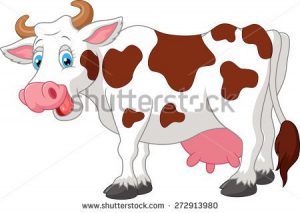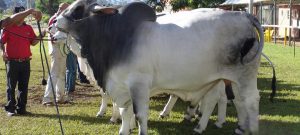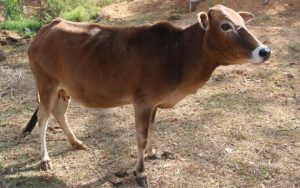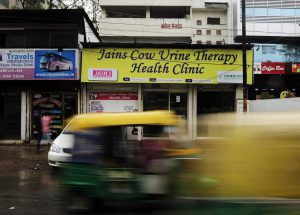The good old cow was mooing along and minding her business when suddenly the Narendra Modi government was elected and she was catapulted from minor celebrity status to headline grabbing stardom. Everyone wants to protect her; self-appointed cow vigilantes have cropped all over the country who have no qualms in committing murder in her name. Prime minister Narendra Modi last week issued a statement condemning self styled cow protectors as “anti-social”. Recently a PIL was also filed in the Supreme Court calling for a ban on cow vigilantes.
The BJP government has introduced several cow friendly measures. ‘Gaushalas’ (cow shelters) have been built for the cow’s protection. The government recently hosted a national conference on ‘gaushalas’; started the Rashtriya Gokul Mission, which involves constructing havens for retired and ailing cows and the state of Rajasthan has its own Ministry for Cow Affairs with Ottaram Devasi as its first Gaupalan Mantri (cow minister).
Like any other celebrity, the cow is just a pawn in a larger game, being exploited by sharks who want to piggyback on her for their own mean ends. The state of Rajasthan, with its first ever cow minister, is also the state where recently more than 500 cows (five hundred) starved to death.
Intellectual Property and the Cow
The world of IP has also had its fair share of run-ins with the cows and bulls. A quick recap of some of the most interesting cow disputes involving IP below:
Ongole Bull Controversy
Last year a Brazilian team made an application to the National Biodiversity Authority to obtain 5,000 (Five Thousand) units of the germplasm of the Ongole Bull. The Ongole bull, a giant among bulls, is found in Andhra Pradesh. Among its many distinctive qualities it is known to be resistant to disease; survives well in drought; is used in farming and milking and is very popular for its meat. It has been exported to Brazil for years. The Brazilians improved on it and developed their own crossbreed version known as the Brahma. However every few years Brazilian breeders, to maintain pure bloodlines, need a fresh infusion of cattle germplasm from India. This practice is usually carried out covertly through middlemen. This has led to concerns of India’s biodiversity being trafficked.
However, since the National Biological Diversity Act, 2002 (“Act”), a foreign company or foreign person is required to obtain approval of the National Biodiversity Authority (“Authority”) under Section 3 of the Act. Approval is required to obtain any biological resource occurring in India or biological knowledge for research or for commercial utilization (such as use in drugs, industrial enzymes, food flavours, cosmetics, fragrance etc.) or for bio-survey and bio-utilisation (which includes survey or collection of species, genes, biological resources etc.)
Under the Act, the Authority has the power to impose benefit sharing fee or royalty or any other conditions including the sharing of financial benefits arising out of commercial utilisation of rights granted.
Vechur Cow Controversy
Moving from the giant Ongole bull, at the other end of the spectrum, is the Vechur dwarf cow. The Vechur cow, from Kottayam in Kerala, is one of the smallest varieties of cattle in the world. It is a small backyard cow known for its high resistance to diseases, low fodder requirement, high fat milk, ability to withstand drought and emits lesser methane when compared to other cows. A Vechur cow’s milk is also believed to have rare medicinal properties.
The once nearly extinct variety required special conservation efforts by the Kerala Agricultural University (“KAU”) to steady its falling numbers. In 1998-1999, the Vechur cow found itself in the midst of a bio piracy controversy. Vandana Shiva, the famous Indian environmentalist, alleged that the Roslin Institute in Edinburgh in UK had patented the genetic material of the Vechur cattle for research purposes. She alleged that the Roslin Institute had surreptitiously obtained embryos of the breed and had smuggled the embryo out of Kerala. The Roslin Institute denied the allegations at the time and no conclusive proof was found substantiating her claim either.
The Vechur cow is particularly vital because of its unique gene pool, which has developed by natural selection over the years. The gene pool is especially important to improve genetic variety during cross breeding efforts.
Cow Urine
One of the most controversial topics in recent times is patenting cow urine. The benefits of cow urine may seem overstated in light of some reports which have gone as far as to claim that cow urine contains gold! Patents have been granted in the US to cow urine distillate in its use as a bioenhancer. This essentially means that it has the potential to increase the efficacy of drugs such as antibiotics and anti-cancer agents on the body. A smaller amount of a drug given along with a bioenhancer can produce the same biological effect in the body as a larger amount given alone. However none of these claims have been proved substantially. Recent reports and the new IP policy suggest that the Indian government, too, maybe looking at patenting cow urine.
Finally, for a more global perspective on the cow and its cousins’ run-ins with IP, the IP Kat has periodically run a series of posts involving the cow and trademark disputes including Milka’s purple and white milk chocolate cow, Red Bull’s energy drink and Laughing Cow cheese.





Very interesting article. Introductory part is excellent.
Many thanks for your kind comments Praveen.
excellent! Very informative.
Thank you so much!